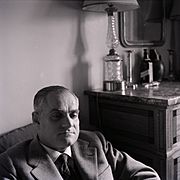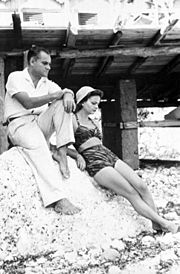Alberto Moravia facts for kids
Quick facts for kids
Alberto Moravia
|
|
|---|---|

Alberto Moravia photographed by Paolo Monti (Fondo Paolo Monti, BEIC)
|
|
| Born | Alberto Pincherle November 28, 1907 Rome, Italy |
| Died | September 26, 1990 (aged 82) Rome, Italy |
| Resting place | Campo Verano, Rome |
| Pen name | Alberto Moravia |
| Occupation | Novelist, journalist, playwright, essayist, film critic |
| Nationality | Italian |
| Notable works | Gli indifferenti (Time of Indifference, 1929) Il conformista (The Conformist, 1947) Racconti romani (Roman Tales, 1954) La ciociara (Two Women, 1957) |
| Notable awards | Strega Prize (1952) Premio Marzotto (1957) Viareggio Prize (1961) Premio Mondello (1982) |
| Spouse | |
| Partner | Dacia Maraini (1962–1978) |
|
|
|
Alberto Moravia ( moh-RAH-vee-Ə-,_--RAY-- born Alberto Pincherle November 28, 1907 – September 26, 1990) was an Italian novelist and journalist.
Contents
Biography
Early years
Alberto Pincherle (the pen name "Moravia" was a surname linked to the family) was born in Via Sgambati in Rome, Italy, to a wealthy middle-class family. His father, Carlo, was an architect and a painter. His mother, Teresa Iginia de Marsanich, was of Dalmatian origin.
Moravia did not finish conventional schooling because, at the age of nine, he contracted tuberculosis of the bone, which confined him to bed for five years. He spent three years at home and two in a sanatorium near Cortina d'Ampezzo, in north-eastern Italy. Moravia was an intelligent boy, and devoted himself to reading books and some of his favourite authors were Giosuè Carducci, Giovanni Boccaccio, Fyodor Dostoevsky, James Joyce, Ludovico Ariosto, Carlo Goldoni, William Shakespeare, Molière, Nikolai Gogol and Stéphane Mallarmé. He learned French and German and wrote poems in French and Italian.
In 1925 at the age of 18, he left the sanatorium and moved to Bressanone. During the next three years, partly in Bressanone and partly in Rome, he began to write his first novel, Gli indifferenti (Time of Indifference), published in 1929. Gli indifferenti was published at his own expense, costing 5,000 Italian lira. Literary critics described the novel as a noteworthy example of contemporary Italian narrative fiction.
In 1927, Moravia met Corrado Alvaro and Massimo Bontempelli and started his career as a journalist with the magazine 900. The journal published his first short stories.
Fascist ostracism
The years leading to World War II were difficult for Moravia as an author; the Fascist regime prohibited reviews of Le ambizioni sbagliate (1935), seized his novel La mascherata (Masquerade, 1941) and banned Agostino (Two Adolescents, 1941). In 1935 he traveled to the United States to give a lecture series on Italian literature. To avoid Fascist censorship, Moravia wrote mainly in the surrealist and allegoric styles. The Fascist seizure of the second edition of La mascherata in 1941, forced him to write under a pseudonym. That same year, he married the novelist Elsa Morante, whom he had met in 1936. They lived in Capri, where he wrote Agostino. After the Armistice of September 8, 1943, Moravia and Morante took refuge in Fondi, on the border of province of Frosinone, a region to which fascism had arbitrarily imposed the name "ciociaria"; the experience inspired La ciociara (The ciociara Woman, 1957).
Return to Rome and national popularity
In May 1944, after the liberation of Rome, Alberto Moravia returned. He began collaborating with Corrado Alvaro, writing for important newspapers such as Il Mondo and Il Corriere della Sera, the latter publishing his writing until his death. After the war, his popularity steadily increased. In 1952 he won the Premio Strega for I Racconti and his novels began to be translated abroad. In 1953, Moravia founded the literary magazine Nuovi Argomenti (New Arguments), which featured Pier Paolo Pasolini among its editors. From 1957, he also reviewed and criticised cinema for the weekly magazines L'Europeo and L'Espresso.
Later life
In 1962, Moravia and Elsa Morante parted, but never divorced. He went to live with the young writer Dacia Maraini and concentrated on theatre. In 1966, he, Maraini and Enzo Siciliano founded Il Porcospino, which staged works by Moravia, Maraini, Carlo Emilio Gadda and others.
His 1982 trip to Japan, including a visit to Hiroshima, inspired a series of articles for L'Espresso magazine about the atomic bomb. The same theme is in the novel L'Uomo che Guarda (The Man Who Looks, 1985) and the essay L'Inverno Nucleare (The Nuclear Winter), including interviews with some contemporary principal scientists and politicians.
The short story collection, La Cosa e altri racconti (The Thing and Other Stories), was dedicated to Carmen Llera, his new companion (forty-five years his junior), whom he married in 1986, after Morante's death in November 1985. In 1984, Moravia was elected to the European Parliament as member from the Italian Communist Party. In 1985 he won the title of European Personality. Moravia was a perennial contender to the Nobel Prize in Literature, having been nominated 13 times between 1949 and 1965.
Between 1959 and 1962 Moravia was president of PEN International, the worldwide association of writers.
Works
Moravia is best known for his debut novel Gli indifferenti (1929) and for the anti-fascist novel Il Conformista (The Conformist), the basis for the film The Conformist (1970) directed by Bernardo Bertolucci. Other novels of his adapted for the cinema are Agostino, filmed with the same title by Mauro Bolognini in 1962; Il disprezzo (A Ghost at Noon or Contempt), filmed by Jean-Luc Godard as Le Mépris (Contempt 1963); La Noia (Boredom), filmed with that title by Damiano Damiani in 1963 and released in the US as The Empty Canvas in 1964 and La ciociara, filmed by Vittorio De Sica as Two Women (1960). Cédric Kahn's L'Ennui (1998) is another version of La Noia.
Death
Alberto Moravia died in 1990, in Rome. In that year, Bompiani published his autobiography, Vita di Moravia (Life of Moravia).
See also
 In Spanish: Alberto Moravia para niños
In Spanish: Alberto Moravia para niños


